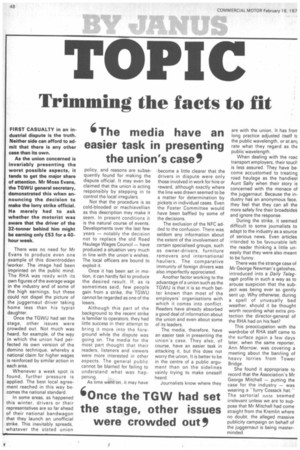Trimming the facts to fit
Page 50

If you've noticed an error in this article please click here to report it so we can fix it.
'The media have an easier task in presenting the union's case,
FIRST CASUALTY in an industrial dispute is the truth. Neither side can afford to admit that there is any other case than its own.
As the union concerned is invariably presenting the worst possible aspects, it tends to get the major share of attention. Mr Moss Evans, the TGWU general secretary, demonstrated this when announcing the decision to make the lorry strike official. He merely had to ask whether the motorist was aware that the driver of the 32-tonner behind him might be earning only £53 for a 40hour week.
There was no need for Mr Evans to produce even one example of this downtrodden worker. The image had been imprinted on the public mind. The RHA was ready with its own figures of the average wage in the industry and of some of the high earnings, but these could not dispel the picture of the juggernaut driver taking home less than his typist daughter.
Once the TGWU had set the stage, other issues were crowded out. Not much was heard, for example, of the way in which the union had perfected its own version of the domino technique, whereby a national claim for higher wages is reinforced by similar action in each area.
Whenever a weak spot is found, further pressure is applied. The best local agreement reached in this way becomes the national standard.
In some areas, as happened this winter, drivers or their representatives are so far ahead of their national bandwagon that they launch an unofficial strike. This inevitably spreads, whatever the stated union policy, and reasons are subsequently found for making the dispute official. It may even be claimed that the union is acting responsibly by stepping in to control the local irregulars.
Not that the procedure is as cold-blooded or machiavellian as this description may make it seem. In present conditions it is the natural course of events. Developments over the last few years — notably the decision not to replace the old Road Haulage Wages Council — have produced a situation very much in line with the union's wishes. The local officers are bound to exploit it.
Once it has been set in motion, it can hardly fail to produce the desired result. If, as is sometimes said, few people gain from a strike, the TGWU cannot be regarded as one of the losers.
Although this part of the background to the recent strike is familiar to operators, they had little success in their attempt to bring it more into the foreground while the dispute was going on. The media for the most part thought that their readers, listeners and viewers were more interested in other aspects. The general public cannot be blamed for failing to understand what was happening.
As time went on, it may have become a little clearer that the drivers in dispute were only those involved in work for hire or reward, although exactly where the line was drawn seemed to be a matter for determination by pickets in individual cases. Even the Foster Committee would have been baffled by some of the decisions The exclusion of the NFC added to the confusion. There was seldom any information about the extent of the involvement of certain specialised groups, such as owner-drivers, furniture removers and international hauliers. The comparative immunity of foreign drivers was also imperfectly appreciated.
Another factor working to the advantage of a union such as the TGWU is that it is so much better known than most of the employers' organisations with which it comes into conflict. Readers have already absorbed a good deal of information about the union and even about some of its leaders.
The media, therefore, have an easier task in presenting the union's case. They also, of course, have an easier task in attacking it, but this does not worry the union It is better to be in the centre of a public argument than on the sidelines vainly trying to make oneself heard.
Journalists know where they are with the union. It has frorr long practice adjusted itself tc the public wavelength, or at an rate what they regard as the public wavelength.
When dealing with the roac transport employers, their touch is less assured. They have become accustomed to treating road haulage as the handiest Aunt Sally when their story is concerned with the menace of the juggernaut. Because the industry has an anonymous face, they feel that they can all the more safely fire their broadsides and ignore the response.
During the strike, it seemed difficult to some journalists to adapt to the industry as a source of serious news. Even articles intended to be favourable left the reader thinking a little uneasily that they were also meant to be funny.
There was the strange case of Mr George Newman's galoshes, introduced into a Daily Telegraph profile in such a way as to arouse suspicion that the subject was being ever so gently sent up. Why otherwise, during a spell of unusually bad weather, should it be thought worth recording what extra protection the director-general of the RHA had on his feet?
This preoccupation with the wardrobe of RHA staff came to the surface again a few days later, when the same reporter, Ann. Morrow, was covering a meeting about the banning of heavy lorries from Tower Bridge.
She found it appropriate to record that the Association's Mr George Mitchell — putting the case for the industry — was
wearing a -furry Cossack hat.The sartorial note seemed
irrelevant unless we are to sup pose that Mr Mitchell had come straight from the Kremlin where no doubt, the alleged massive publicity campaign on behalf of the juggernaut is being masterminded.




















































































































